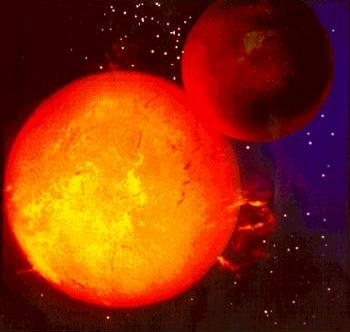- 51 Pegasi b
Planetbox begin
name = 51 Pegasi b Planetbox image

caption = An artist's impression of 51 Pegasi b staring at its sun. Planetbox star
star =51 Pegasi
constell = Pegasus
RA = RA|22|57|28.0
DEC = DEC|+20|46|08
dist_ly = 50.1
dist_pc = 15.4
class = G4V Planetbox orbit
semimajor = 0.0527 ± 0.0030
eccentricity = 0.013 ± 0.012
period = 4.230785 ± 0.000036
ang_dist = 3.537
long_peri = 58
t_peri = 2,450,001.51 ± 0.61
semi-amp = 55.94 ± 0.69Planetbox character
mass = >0.472 ± 0.039 Planetbox discovery
discovery_date =6 October 1995
discoverers =Michel Mayor andDidier Queloz
discovery_site= flagicon|France Haute-Provence
discovery_method = Radial velocity
discovery_status = Published Planetbox catalog
names =Bellerophon , HD 217014 b51 Pegasi b, also unofficially named Bellerophon and or abbreviated as 51 Peg b, is an
extrasolar planet approximately 50light-year s away in theconstellation of Pegasus. 51 Pegasi b was the first planet to be discovered orbiting aSun-like star (51 Pegasi ) and is the prototype for a class of planets calledhot Jupiter s.Name
The name "51 Pegasi b" is the official astronomical name of the planet. As with all
extrasolar planet s, the 'b' is used to indicate that this planet was the first discovered companion of its parent star. Further undiscovered companions of 51 Pegasi would be designated c, d, e, f, and so on. All extrasolar planets havelowercase letter to differentiate from companion stars in the system (which are designated with anuppercase letter).Though not officially recognized, the name "Bellerophon" is commonly used for the planet. [http://jumk.de/astronomie/exoplanets/51-pegasi.shtml] This name comes from the Greek hero
Bellerophon , who tamedPegasus (the Winged Horse). This has direct relations with the constellation in which lies the planet (Pegasus). This name is usually used as the informal name to show the similarities to the planets of theSolar system , while the " [http://wiki.answers.com/Q/Is_Bellerophon_the_name_of_a_planet latter name] " is used astronomically. Only two other extrasolar planets were given unofficial or informal names ("Osiris" and "Methuselah").Discovery
The exoplanet's discovery was announced on
October 6 1995 byMichel Mayor andDidier Queloz in "Nature", volume 378, page 355, using the radial velocity method at theObservatoire de Haute-Provence with theELODIE spectrograph .After the announcement, on
October 12 ,1995 , confirmation came from Dr.Geoffrey Marcy fromSan Francisco State University and Dr. Paul Butler from theUniversity of California, Berkeley using theHamilton Spectrograph at theLick Observatory near San Jose inCalifornia .The planet was discovered using a sensitive
spectroscope that could detect the slight, regular velocity changes in the star's spectral lines of around 70 metres per second. These changes are caused by the planet's gravitational effects from just 7 million kilometres distance from the star.This discovery of this first exoplanet established a milestone in astronomical research, as it forced astronomers to realize that giant planets could exist in short period orbits. Once astronomers realized that it was worth looking for giant planets with the currently available technology, much more telescope time was devoted to radial velocity planet searches, and hence many more exoplanets in the Sun's neighbourhood have been discovered.
Physical characteristics
After its discovery, many teams confirmed the planet's existence and obtained more observations of its properties. It was discovered that the planet orbits the star in around 4 Earth days, and is much closer to it than Mercury is to our Sun, and moves at an
orbital speed of 136 km/s, yet has a minimum mass about half that of Jupiter (about 150 times that of the Earth). At the time, the presence of a huge world so close to its star was not compatible with theories ofplanet formation and was considered an anomaly. However, since then, numerous other 'hot Jupiters' have been discovered (see55 Cancri and τ Boötis, for example), and astronomers are revising their theories of planet formation to account for them by studyingorbital migration .Assuming the planet is perfectly grey with no greenhouse or tidal effects, and a Bond albedo of 0.1, the temperature would be 1265K (around 1000 degrees
Celsius / 1800 degreesFahrenheit ). This is between the predicted temperatures ofHD 189733 b andHD 209458 b (1180-1392K), before they were measured.cite arXiv | title=Prospects for near-infrared characterisation of hot Jupiters with the VLTI Spectro-Imager (VSI) |author=Renard, S. "et al."|year=2008| eprint=0807.3014v1 |class=astro-ph]It was initially assumed that 51 Pegasi b is a
terrestrial planet , but it is now believed to be agas giant . It is sufficiently massive that its thick atmosphere is not blown away by the star'ssolar wind .51 Pegasi b probably has a greater
radius than Jupiter despite its lower mass. This is because its superheated atmosphere must be puffed up into a thick but tenuous layer surrounding it. Beneath this, the gases that make up the planet would be so hot that the planet would glow red. Clouds ofsilicates may exist in the atmosphere.The planet is tidally locked to its star, always presenting the same face to it.
The planet (with
Upsilon Andromedae b ) is deemed a candidate for direct imaging by Planetpol.cite arXiv | title=Planetpol polarimetry of the exoplanet systems 55 Cnc and tau Boo | author=P.W.Lucas "et al." | eprint=0807.2568v1 | year=2007 | class=astro-ph ] It is also a candidate for "near-infrared characterisation.... with the VLTI Spectro-Imager".The earlier, rocky-planet model was utilized as a setting by
Hal Clement in the story [http://www.amazon.com/gp/product/0312264178 "Exchange Rate"] .See also
*
PSR B1257+12B
*PSR B1257+12C
*HD 209458 b References
*cite journal | url=http://www.nature.com/nature/journal/v378/n6555/abs/378355a0.html | author=Mayor et al.| title=A Jupiter-mass companion to a solar-type star | journal=Nature | volume=378 |year=1995 | pages=355–359| doi=10.1038/378355a0| format=abstract
*cite journal|url=http://www.journals.uchicago.edu/doi/abs/10.1086/504701|author=Butler, R. et al.|title=Catalog of Nearby Exoplanets|journal=The Astrophysical Journal |volume=646|pages=505–522|year=2006|doi=10.1086/504701|format=abstract ( [http://exoplanets.org/planets.shtml web version] )External links
*
*
*
*
*
Wikimedia Foundation. 2010.
